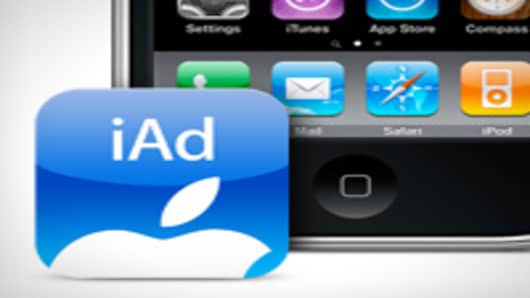Apple's new iAd platform debuts today, but without any of the flash or excitement of Apple's gadget debuts.
It's too soon to judge the new interactive ad platform: just Nissan and Unilever are launching iAds today, though seventeen brands from General Electric to Chanel to Best Buy committed to spend over $60 million on the iPhone platform back in April.
Why such a soft launch?
Apple is controlling the production of the ads, which is unprecedented for an ad platform, and it's tacking six to eight weeks onto marketers' timeline. None of the advertisers still working on iAds would speak on the record, but several ad execs told me the lengthy process to get an iAd ready to launch is unsustainable.
My industry sources tell me they appreciate Apple's focus on making their ads maximize the potential of the platform and don't suffer from any bugs. But it seems the real reason for their patience is the fact that they're eager to capture the buzz of being an early presence on this hot platform.
The key differentiating factor of iAds is that they offer interactive, in-depth experiences, without taking users away from the app they're on. The ads are tailored to certain apps and targeted to reach investors and engage them for longer than a traditional mobile ad. App users can click on an ad within an app, explore a virtual space or watch a video, without having to worry about losing their place in an article or their spot in a game. Several digital marketing execs say that they're most excited about the ability to download an application from an ad in another app — it's a great way to get more people to engage with their brands.
This comes at a price: iAd charges $10 per 1,000 views, or "impressions," plus $2 per click-through. Average mobile click-through is 1%; at that rate advertisers are paying $30 per 1,000 impressions. It's unprecedented to charge for both impressions and click-through — ad execs I spoke to say they're charged for either one or the other. Google's AdMob charges for either, but typically charges $10 to $15 (determined at auction) for 1,000 impressions. That's a big price difference, but advertisers say for now, it's worth it. Ad industry sources tell me that in six to eight months they expect prices — and the length of time to produce ads-- to drop.
Unilever's Dove is using the iAd platform for its Dove Men + Care campaign, which tells the stories of athletes including Albert Pujolsand Andy Pettitte. The iAd allows users to take a virtual tour of the baseball players’ homes, clicking throughout for more details. Users can also play what Dove is calling a "virtual sweepstakes" game, where users can click on the app to instantly win prizes. Dove won't get specific, but tells me it expects the audience to "spend significantly more time" on their platform in iAd than on their other mobile ad efforts.
Nissan is iAd's exclusive auto advertiser, spending millions of dollars to promote its new Leaf electric car. Nissan is embedding a 30 second video into its iAd, it's hosting a sweepstakes and it's asking consumers to register for more information to order the Leaf. Nissan tells us it's signed up for a six month commitment to iAd and plans to change it's creative message three or four times to react to 'engagement' metrics Apple provides.
This is a brave new world of mobile advertising and there are several outstanding questions — will consumers even want ads in their apps? Will Apple need to bring in an outside company to measure the efficacy of ads? And how long until Apple opens up and speeds up the production process. In the meantime, Madison Avenue is watching carefully and hoping today's two ad launches generate some serious buzz.
Questions? Comments? MediaMoney@cnbc.com



